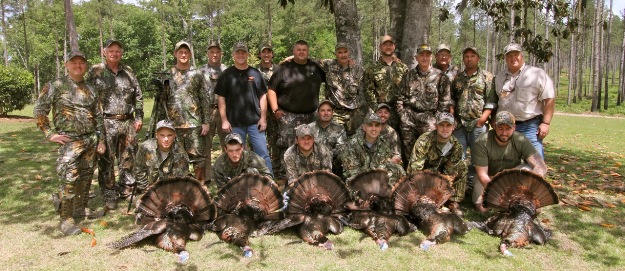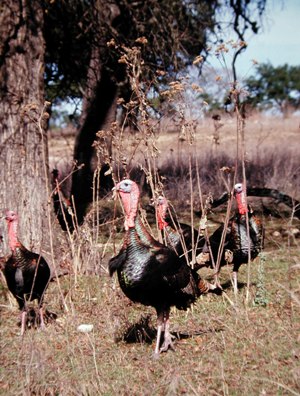with Kevin Burleson

Editor’s Note: Mossy Oak’s Kevin Burleson, one of Mossy Oak’s THUGs, guides at Heart of Texas Bowhunting near Brady, Texas – both bow and shotgun hunters – for turkeys each spring. In Texas, hunters can hunt and take Rio Grande gobblers. If you’ve been hunting eastern wild turkeys all your life, you’ll think you’ve died and gone to heaven, if you have the opportunity to hunt Rio Grandes on a ranch that has plenty of birds like Heart of Texas Bowhunting does. We’ve asked Kevin to tell us some of the major differences between hunting eastern gobblers and Rio Grande turkeys.
One of the elements that most of our hunters seem to enjoy about calling Rio Grande gobblers is that you can have a good time with your turkey caller. You can hammer a Rio Grande gobbler until you build his emotional temperature into a frenzy. The hunters can get loud and vocal, when they talk to a Rio Grande, most of the time. Having said that, there are some times during the season, when you have to come off that loud, repetitive calling and give the Rio Grande the silent treatment. But continuing to call to a Rio and have him gobble almost every time he breathes isn’t an uncommon occurrence. The Rio Grande tom is much more vocal than the eastern wild turkey. For this reason, he’s often a better turkey to hunt with a bow than the eastern gobbler is.
We have two types of bowhunts for turkeys, here on our ranch. We have the traditional turkey hunt – the hunter hunts from a blind that we set-up in an area where we know turkeys like to come. We’ll put the hunter in the blind often with a cameraman. Normally, we won’t call as aggressively to a gobbler we’re trying to get to come to a blind as we do when we’re hunting outside the blind, because we want the gobbler to come in looking for a hen. If we call aggressively to a turkey, when we’re stationary in a blind, there’s a very good chance that since we can’t move closer to the turkey, when we call, some real hens will go to him and shut him up. That’s also why we rarely use decoys with Rios when bowhunters want to hunt from blinds. If a hen comes in before the gobbler does and sees those decoys, she’ll often run to the gobbler and lead him away from us.
 The other type of bowhunting we have for Rio Grande gobblers is no-blind bowhunting. This is where Mossy Oak camouflage is really critical. When we’re hunting without a blind, the set-up becomes more important than the calling strategy. We may set-up and call in seven or eight different gobblers, before we call in one gobbler that comes in to where we want him to come and presents the shot to our bowhunter. We usually run-and-gun when we’re bowhunting without a blind.
The other type of bowhunting we have for Rio Grande gobblers is no-blind bowhunting. This is where Mossy Oak camouflage is really critical. When we’re hunting without a blind, the set-up becomes more important than the calling strategy. We may set-up and call in seven or eight different gobblers, before we call in one gobbler that comes in to where we want him to come and presents the shot to our bowhunter. We usually run-and-gun when we’re bowhunting without a blind.
To be successful, there’s one critical element that we must have. We must be well hidden behind bushes, trees and/or brush to keep the turkey from seeing us. We also must have a tree or a bush between 15 and 20 yards of where we expect the turkey to come from that the turkey has to walk behind. Then our bowhunter can get his bow drawn and wait for the turkey to step out from behind the cover. He has to make sure he can’t see the turkey’s head, when he draws the bow, if he’s hunting without a blind. If he can see the turkey’s head, the tom can see the hunter draw the bow.
We’ve been very successful in helping our hunters take Rio Grande gobblers with their bows, whether they hunt from a blind or hunt without a blind. However, when a bowhunter chooses to hunt without a blind, we usually have to call in more Rios to try and get him a shot than we have to call in for the bowhunter who’s hunting with the aid of a blind.
If you like listening to turkeys talk, if you like hearing and seeing several gobblers during the morning and the afternoon hunt, if you dream about hearing 20 gobblers gobbling from one area, then a Rio Grande turkey hunt needs to be on your hunting agenda. The Rio Grande turkey is more likely to do what a turkey’s supposed to do, when a turkey’s supposed to do it, than an eastern gobbler is. I think the Rio Grande is easier to pattern. Most of the time, they’re easier to call than the eastern gobbler. But of course, that’s just my opinion. It’s also what hundreds of hunters have told me, who hunt turkeys primarily in the East.






























